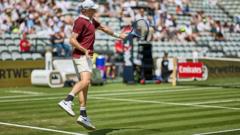Is Wimbledon’s Grass Playing More Like Clay?

Wimbledon 2025: The Impact of Court Conditions on Players' Performance
As the Wimbledon 2025 tournament unfolds, players are facing unique challenges that extend beyond their opponents. The grass courts, under the scorching summer sun, have sparked a whirlwind of opinions from athletes regarding their playability. With complaints about the surface and atmospheric conditions, the iconic All England Club is witnessing a shift in how the game is perceived at the Grand Slam. This article delves into the nuances of court conditions, player experiences, and the broader implications for tennis at Wimbledon and beyond.
The Setting: Wimbledon 2025
Wimbledon is not just a tennis tournament; it is a revered tradition that takes place at the All England Club from June 30 to July 13 every year. As one of the four Grand Slam tournaments, it holds a unique place in the hearts of players and fans alike. This year, however, players are facing unprecedented challenges due to weather conditions and court surface characteristics.
Record High Temperatures
The 2025 tournament kicked off with record-breaking temperatures, with the opening day reaching a staggering 32.3°C. The heat intensified on the following day, peaking at 33.4°C. Such extreme conditions not only affect players' endurance but also impact how the grass courts perform and how the tennis balls react during play.
Players' Frustrations with the Surface
Multiple players have openly voiced their frustrations regarding the grass courts this year. Notably, Denis Shapovalov, the Canadian player ranked 27th, described the courts as "slower than a clay one," lamenting the quality of the balls and suggesting that the grass has become almost unplayable. His sentiment resonates with many players who feel that the essence of grass-court tennis is being compromised.
Defending Champions Speak Out
Defending women's champion Barbora Krejcikova echoed similar concerns, highlighting that the grass is "stopping" due to the intense heat and inadequate watering. This sentiment was further amplified by Petra Kvitova, a two-time champion, who remarked on the overall changes to Wimbledon courts over the years, suggesting that both the grass and the balls have contributed to a slower game.
The Evolution of Grass Courts
Historically, grass courts have been known for their quick play and serve-and-volley style. However, since 2001, Wimbledon has made significant changes to its grass composition, opting for perennial ryegrass. This switch was intended to enhance durability, allowing the courts to withstand the rigors of modern play and maintain visual appeal throughout the tournament.
Shifting Dynamics of Play
- Slower Courts: The evolution of grass at Wimbledon has led to slower courts, resulting in longer rallies and more physically demanding matches.
- Adaptation of Tactics: Players are now required to adjust their tactics, incorporating kick serves and other strategies that were previously less effective on grass.
- Balance Between Aesthetics and Playability: Wimbledon aims to provide an aesthetically pleasing experience for fans while ensuring competitive integrity, leading to the current court conditions.
Physical and Mental Strain on Players
The combination of high temperatures and slower court conditions can lead to a physically taxing experience for players. Longer rallies mean more running, which can increase the risk of fatigue and injury. The mental strain is equally significant, as players must continuously adapt their strategies to meet the evolving conditions.
Impact on Match Duration
With slower surfaces leading to longer rallies, match durations are expected to increase. This not only affects player stamina but can also influence the scheduling of matches and the overall spectator experience. Players have expressed concerns about the physical toll that longer matches can take, especially in such hot conditions.
The Science Behind Court Conditions
Understanding the physics of tennis courts is essential for grasping the current state of play at Wimbledon. Several factors influence the speed of the courts, including:
- Soil Compaction: Over time, the soil beneath the grass becomes compacted, affecting how the ball bounces.
- Weather Conditions: Warm and dry conditions make the ball lighter and faster, while cold and damp weather can have the opposite effect.
- Grass Maintenance: Wimbledon cuts the grass to a uniform height of eight millimeters and waters the courts to maintain their condition, but even minor variations can significantly influence playability.
The Role of the Tennis Ball
Another crucial element is the tennis ball itself. Since 1995, there have been minimal changes to the ball's compression, which can impact how it interacts with the grass surface. The ongoing feedback from players about the ball's performance indicates a need for continual evaluation and potential adjustments to enhance play.
Player Testimonials and Insights
As the tournament progresses, the perspectives of players provide valuable insights into the complexities of competing at Wimbledon. Iga Swiatek, a former world number one, noted that while the conditions felt slower and more slippery initially, she anticipated adjustments could be made as the weather changes. This adaptability is crucial for players aiming to thrive in fluctuating environments.
Long-term Trends in Grass Court Tennis
Former doubles player Dom Inglot highlighted that since 2001, there has been a noticeable shift towards slower grass courts. This change has altered the landscape of play, moving away from traditional serve-and-volley tactics and towards longer baseline rallies.
Looking Ahead: The Future of Wimbledon
The ongoing discussions around court conditions at Wimbledon raise questions about the future of grass-court tennis. Will the All England Club continue to adapt the surface to meet the demands of modern players? Or will there be a return to a faster, more traditional grass experience? The evolution of the sport relies heavily on such decisions and the feedback from players, fans, and experts alike.
Conclusion: Adapting to Change
The 2025 Wimbledon tournament has brought to light significant challenges and changes in the game of tennis, particularly concerning court conditions. As players adapt to slower surfaces and unprecedented heat, the spirit of competition remains at the forefront. Understanding these dynamics not only enhances our appreciation for the sport but also allows us to anticipate future developments. The conversations around these changes are vital as they will shape the future of tennis at Wimbledon and beyond.
FAQs
What are the main complaints from players about the Wimbledon 2025 courts?
Players have expressed frustrations about the slower surface, with many comparing it to playing on clay. The heat and conditions have contributed to a different ball bounce, impacting their performance.
How do weather conditions affect grass court play?
Weather influences the speed and bounce of the ball. Warm and dry conditions typically make the ball lighter and faster, while cold and damp conditions can slow it down.
What has changed about Wimbledon courts since 2001?
Since 2001, Wimbledon has shifted to using perennial ryegrass, designed for durability and to withstand wear. This has resulted in slower court conditions, altering the style of play.
How do players adapt their strategies on slower grass courts?
Players are now employing more kick serves and longer rallies, adapting their strategies to accommodate the slower surfaces rather than relying solely on traditional serve-and-volley tactics.
The state of play at Wimbledon 2025 illustrates the ongoing evolution of tennis, shaped by numerous factors, from court surfaces to player strategies. How do you feel about the changes in grass-court tennis? Will these adaptations lead to a new era in the sport? #Wimbledon2025 #TennisEvolution #GrassCourtChallenges
Published: 2025-07-01 23:25:21 | Category: sport



